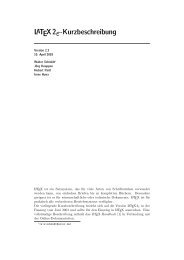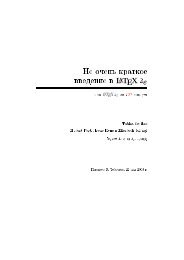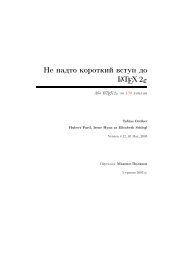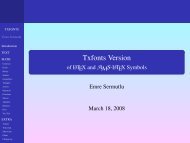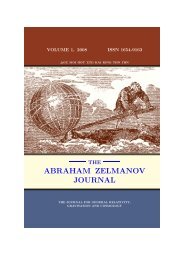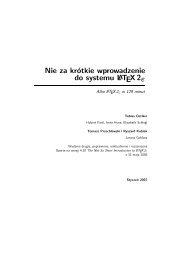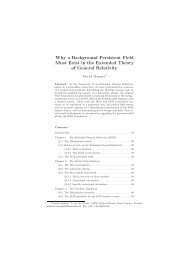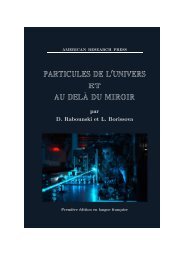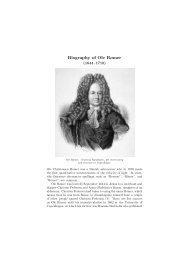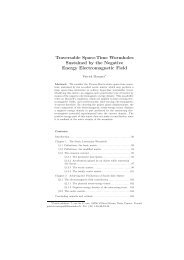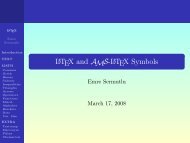• <strong>The</strong> symbol isn’t intuitively named. As a few examples, the ifsym command to draw dice is “\Cube”; aplus sign with a circle around it (“exclusive or” to computer engineers) is “\oplus”; and lightning boltsin fonts designed by German speakers may have “blitz” in their names as in the ulsy package. <strong>The</strong> moralof the story is to be creative with synonyms when searching the index.• <strong>The</strong> symbol is defined by some package that I overlooked (or deemed unimportant). If there’s somesymbol package that you think should be included in the <strong>Comprehensive</strong> L A TEX <strong>Symbol</strong> <strong>List</strong>, please sendme e-mail at the address listed on the title page.• <strong>The</strong> symbol isn’t defined in any package whatsoever.Even in the last case, all is not lost. Sometimes, a symbol exists in a font, but there is no L A TEX bindingfor it. For example, the PostScript <strong>Symbol</strong> font contains a “↵” symbol, which may be useful for representinga carriage return, but there is no package (as far as I know) for accessing that symbol. To produce anunnamed symbol, you need to switch to the font explicitly with L A TEX 2ε’s low-level font commands [L A T00]and use TEX’s primitive \char command [Knu86a] to request a specific character number in the font. 4 In fact,\char is not strictly necesssary; the character can often be entered symbolically. For example, the symbolfor an impulse train or Tate-Shafarevich group (“X”) is actually an uppercase sha in the Cyrillic alphabet.(Cyrillic is supported by the OT2 font encoding, for instance). While a sha can be defined numerically as“{\fontencoding{OT2}\selectfont\char88}” it may be more intuitive to use the OT2 font encoding’s “SH”ligature: “{\fontencoding{OT2}\selectfont SH}”.Reflecting and rotating existing symbolsA common request on comp.text.tex is for a reversed or rotated version of an existing symbol.As a last resort, these effects can be achieved with the graphicx (or graphics) package’s \reflectbox and\rotatebox macros. For example, \textsuperscript{\reflectbox{?}} produces an irony mark (“ ”;cf. http://en.wikipedia.org/wiki/Irony mark), and \rotatebox[origin=c]{180}{$\iota$} produces thedefinite-description operator (“ ”). <strong>The</strong> disadvantage of the graphicx/graphics approach is that not every TEXbackend handles graphical transformations. 5 Far better is to find a suitable font that contains the desiredsymbol in the correct orientation. For instance, if the phonetic package is available, then \textit{\riota}will yield a backend-independent “ ”. Similarly, tipa’s \textrevepsilon (“3”) or wsuipa’s \revepsilon (“”)may be used to express the mathematical notion of “such that” in a cleaner manner than with \reflectboxor \rotatebox. 6Joining and overlapping existing symbolsι<strong>Symbol</strong>s that do not exist in any font can sometimes be fabricated out of existing symbols. <strong>The</strong> L A TEX 2ε sourcefile fontdef.dtx contains a number of such definitions. For example, \models (see Table 62 on page 30) isdefined in that file with:\def\models{\mathrel|\joinrel=}where \mathrel and \joinrel are used to control the horizontal spacing. \def is the TEX primitive uponwhich L A TEX’s \newcommand is based. See <strong>The</strong> TEXbook [Knu86a] for more information on all three of thosecommands.With some simple pattern-matching, one can easily define a backward \models sign (“=|”):\def\ismodeledby{=\joinrel\mathrel|}In general, arrows/harpoons, horizontal lines (“=”, “-”, “\relbar”, and “\Relbar”), and the various mathextensioncharacters can be combined creatively with miscellaneous other characters to produce a variety ofnew symbols. Of course, new symbols can be composed from any set of existing characters. For instance, L A TEXdefines \hbar (“”) as a “¯” character (\mathchar’26) followed by a backspace of 9 math units (\mkern-9mu),followed by the letter “h”:\def\hbar{{\mathchar’26\mkern-9muh}}4 pifont defines a convenient \Pisymbol command for accessing symbols in PostScript fonts by number. For example,“\Pisymbol{psy}{191}” produces “↵”.5 As an example, Xdvi ignores both \reflectbox and \rotatebox.6 More common symbols for representing “such that” include “|”, “:”, and “s.t.”.?90
We can just as easily define other barred letters:\def\bbar{{\mathchar’26\mkern-9mu b}}\def\dbar{{\mathchar’26\mkern-12mu d}}(<strong>The</strong> space after the “mu” is optional but is added for clarity.) \bbar and \dbar define “¯b” and “¯d”, respectively.Note that \dbar requires a greater backward math kern than \bbar; a −9 mu kern would have produced theless-attractive “¯d” glyph.<strong>The</strong> amsmath package provides \overset and \underset commands for placing one symbol respectivelyabove or below another. For example, \overset{G}{\sim} 7 produces “ G ∼” (sometimes used for “equidecomposablewith respect to G”).Sometimes an ordinary tabular environment can be co-opted into juxtaposing existing symbols into a newsymbol. Consider the following definition of \asterism (“ * ** ”) from a June 2007 post to comp.text.tex byPeter Flynn:\newcommand{\asterism}{\smash{%\raisebox{-.5ex}{%\setlength{\tabcolsep}{-.5pt}%\begin{tabular}{@{}cc@{}}%\multicolumn2c*\\[-2ex]*&*%\end{tabular}}}}Note how the space between columns (\tabcolsep) and rows (\\[. . . ]) is made negative to squeeze theasterisks closer together.<strong>The</strong>re is a TEX primitive called \mathaccent that centers one mathematical symbol atop another. Forexample, one can define \dotcup (“ ·∪”)—the composition of a \cup and a \cdot—as follows:\newcommand{\dotcup}{\ensuremath{\mathaccent\cdot\cup}}<strong>The</strong> catch is that \mathaccent requires the accent to be a “math character”. That is, it must be a characterin a math font as opposed to a symbol defined in terms of other symbols. See <strong>The</strong> TEXbook [Knu86a] for moreinformation.Another TEX primitive that is useful for composing symbols is \vcenter. \vcenter is conceptually similarto “\begin{tabular}{l}” in L A TEX but takes a list of vertical material instead of \\-separated rows. Also,it vertically centers the result on the math axis. (Many operators, such as “+” and “−” are also verticallycentered on the math axis.) Enrico Gregorio posted the following symbol definition to comp.text.tex inMarch 2004 in response to a query about an alternate way to denote equivalence:\newcommand*{\threesim}{%\mathrel{\vcenter{\offinterlineskip\hbox{$\sim$}\vskip-.35ex\hbox{$\sim$}\vskip-.35ex\hbox{$\sim$}}}}<strong>The</strong> \threesim symbol, which vertically centers three \sim (“∼”) symbols with 0.35 x-heights of space betweenthem, is rendered as “∼”. \offinterlineskip is a macro that disables implicit interline spacing. Withoutit, \threesim would have a full line of vertical spacing between each \sim. Because of \vcenter, \threesimaligns properly with other math operators: a ÷ b ∼ c × d.A related L A TEX command, borrowed from Plain TEX, is \ooalign. \ooalign vertically overlaps symbolsand works both within and outside of math mode. Essentially, it creates a single-column tabular environmentwith zero vertical distance between rows. However, because it is based directly on TEX’s \ialign primitive,\ooalign uses TEX’s tabular syntax instead of L A TEX’s (i.e., with \cr as the row terminator instead of \\). <strong>The</strong>following example of \ooalign, a macro that defines a standard-state symbol (\stst, “ −◦ ”) as a superscriptedPlimsoll line (\barcirc, “−◦ ”), 8 is due to an October 2007 comp.text.tex post by Donald Arseneau:\makeatletter\providecommand\barcirc{\mathpalette\@barred\circ}\def\@barred#1#2{\ooalign{\hfil$#1-$\hfil\cr\hfil$#1#2$\hfil\cr}}\newcommand\stst{^{\protect\barcirc}}\makeatother7 LATEX’s \stackrel command is similar but is limited to placing a symbol above a binary relation.8 While \barcirc illustrates how to combine symbols using \ooalign, the stmaryrd package’s \minuso command (Table 42 onpage 21) provides a similar glyph (“”) as a single, indivisible symbol.91



